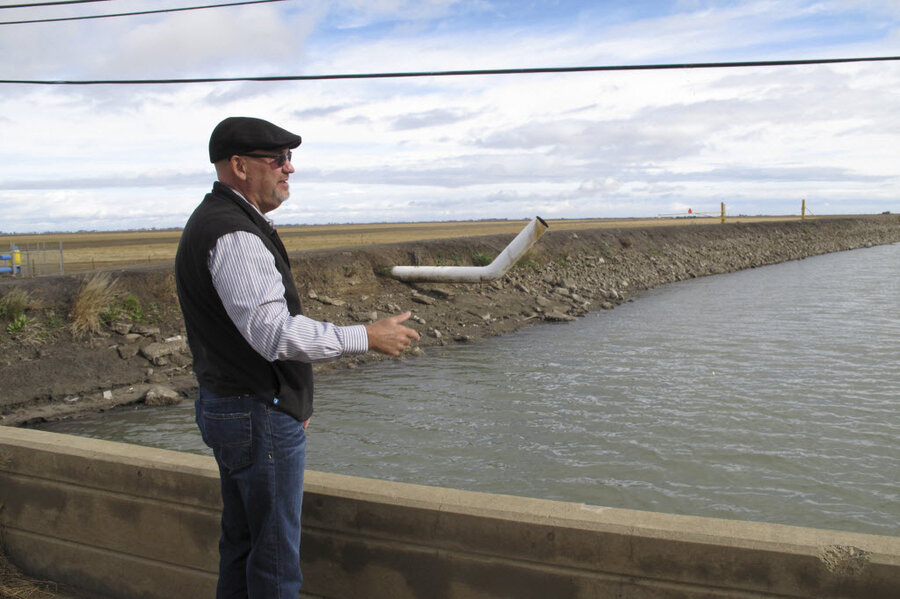Earth as sponge? It has absorbed enough water to slow sea level rise
Loading...
Several regions of Earth that have been battered by rain and floods in the last decade have absorbed enough water to slow global sea level rise by about 20 percent over that time period, scientists say.
And, at least for now, this phenomenon has offset the impact of melting ice sheets, glaciers, and pumping of too much groundwater for irrigation, which also contributes to sea level rise when the water is sprayed on plants, then evaporates into the atmosphere and precipitates back into the ocean in a natural cycle.
"We always assumed that people's increased reliance on groundwater for irrigation and consumption was resulting in a net transfer of water from the land to the ocean," said John T. Reager, a hydrologist at the NASA Jet Propulsion Laboratory in Pasadena, Calif. in an announcement.
"What we didn't realize until now is that over the past decade, changes in the global water cycle more than offset the losses that occurred from groundwater pumping, causing the land to act like a sponge – at least temporarily," he said.
About 3.2 trillion tons of water has been taken up by soils, lakes and underground aquifers in places like the northern Amazon, eastern Australia, parts of the north-central United States, southern Canada, and southeastern Africa. That is enough to fill Lake Huron, the world’s seventh-largest lake, says a team of scientists, led by Dr. Reager, in a study published February 12 in the journal Science.
These trends were observed for the first time by using data collected from a NASA mission called Gravity Recovery and Climate Experiment (GRACE), which is a pair of satellites that orbit Earth constantly measuring the tiny variations in the planet’s gravity field to determine the changes in the amount of water across Earth's surface.
Reager’s findings help explain why sea level rise slowed between 2002 and 2014, despite warmer temperatures on Earth that have continue to melt glaciers and ice sheets, the primary contributors to rising seas along with thermal expansion, or ocean water that’s heating up from a warmer climate and causing the water to expand.
“The melting of ice sheets and glaciers is still going on, but it’s being masked,” Reager told The Christian Science Monitor.
The United Nations' Intergovernmental Panel on Climate Change says that overall sea levels are rising at double the rate of the 20th century, or 3.2 millimeters per year, and that it’s “virtually certain” that this trend will continue for many centuries. More sea water is expected to inundate coasts and islands, erode shorelines, and destroy important ecosystems.
But in a short window between 2002 and 2014, sea level rise slowed at times to 2.4 millimeters, and other times 2.9 millimeters per year, as measured by tide gauges in the oceans around the world and from space satellite radar altimeters. Scientists who study ice sheets, glaciers, and ocean temperatures could not explain the anomaly, because contributions to sea level rise were not declining, says Reager.
“Sometimes we can’t close the budget, meaning things don’t add up,” he told the Monitor. “We think we’re observing everything, but the numbers don’t add up.”
Reager’s team sought to find the missing piece of the sea level equation by analyzing land water data collected by GRACE from 2002 to 2014. Scientists had already suspected that water stored on land could explain the discrepancy, but this had not been measured and quantified until Reager’s experiment.
“It’s the first time that total terrestrial water storage has been monitored,” Marc Bierkens, a hydrology professor at Utrecht University in the Netherlands, who was not involved with the study, told Climate Central. “Not modeled, but monitored — over more than a decade,” he said.
Climate Central reported that other scientists have said the study fills in important data gaps and improves the understanding of how the natural water cycle around the planet affects sea levels.
The next thing scientists want to figure out, says Reager, is why some regions around the globe are storing the extra water.






